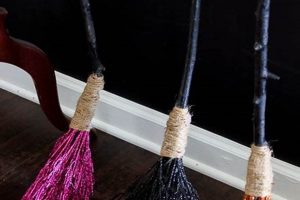The concept involves constructing shelving units from readily available, low-cost materials like corrugated fiberboard, employing do-it-yourself techniques to create functional storage. These structures often provide a lightweight and easily customizable alternative to traditional wooden or metal bookshelves, demonstrating a resourceful approach to home organization.
This approach offers several advantages, including reduced material costs and the potential for sustainable practices by repurposing discarded cardboard. Historically, resourcefulness in creating household items has been a common practice, particularly during times of economic constraint or limited access to manufactured goods. The adaptability of the materials enables solutions tailored to specific spatial needs and aesthetic preferences.
Further exploration of the topic will delve into specific construction methods, design considerations for stability and load-bearing capacity, and potential enhancements to improve the overall aesthetic and durability of these self-made storage solutions. The following sections will present a range of options suitable for various needs and skill levels, along with guidance on selecting appropriate materials and techniques.
Construction Advice for Low-Cost Cardboard Shelving
The following guidelines are presented to assist in the effective and structurally sound creation of shelving units from inexpensive, repurposed materials. Adherence to these points is crucial for safety and longevity.
Tip 1: Material Selection: The quality and thickness of the fiberboard are paramount. Double- or triple-walled corrugated cardboard provides superior load-bearing capacity compared to single-walled varieties. Prioritize sourcing from appliance or furniture packaging for increased robustness.
Tip 2: Structural Design: Employ triangular support structures or gussets to enhance stability. Distribute weight evenly across the shelving unit to prevent localized stress and potential collapse. Experiment with interlocking designs to improve the rigidity of the cardboard joints.
Tip 3: Reinforcement Techniques: Apply adhesive tape, such as packing or duct tape, strategically along the edges and joints to reinforce weak points. Consider using craft glue or wood glue (sparingly, to avoid warping) for stronger bonding of overlapping cardboard layers.
Tip 4: Weight Distribution: Avoid placing heavy items in the center of the shelves. Distribute the load towards the edges or supports to minimize bending and potential failure. Lighter items should ideally occupy the center sections.
Tip 5: Moisture Protection: Cardboard is susceptible to moisture damage. Apply a water-resistant sealant or varnish to protect the shelving unit from humidity and spills. Consider locating the unit in a dry environment to prolong its lifespan.
Tip 6: Joint Construction: Use precise cutting techniques to ensure tight-fitting joints. Overlapping and interlocking construction methods contribute to the overall strength of the structure. Reinforce joints with staples or brad nails for added security.
These strategic methods enhance the practicality and longevity of a cardboard shelving unit. Emphasizing structural integrity and appropriate material selection maximizes the benefits of this cost-effective approach.
The ensuing segments of this discourse will consider aesthetic finishing and alternative implementations of this resourceful approach to home storage.
1. Cost-effectiveness
Cost-effectiveness serves as a primary motivator in the utilization of cardboard as a material for constructing shelving units. The accessibility and minimal expense associated with obtaining cardboard significantly reduce the overall investment required for creating functional storage solutions.
- Reduced Material Costs
Cardboard, often available as a byproduct of packaging and shipping, is frequently obtainable at no cost or minimal expense. This eliminates or substantially reduces the primary expense associated with purchasing lumber, metal, or plastic for shelving construction. Resources otherwise spent on materials can be allocated to other household needs or improvement projects.
- Simplified Tool Requirements
Constructing cardboard bookshelves generally requires only basic tools such as a utility knife, ruler, and adhesive tape. This contrasts with traditional woodworking, which may necessitate specialized and expensive equipment. The lower barrier to entry regarding tooling contributes to the overall cost-effectiveness of the project.
- Minimized Labor Costs
Do-it-yourself construction eliminates the need to hire professional carpenters or furniture assemblers. The inherent simplicity of cardboard construction allows individuals with minimal experience to create functional shelving units independently. This reduces the financial burden associated with labor expenses.
- Potential for Repurposing and Waste Reduction
Employing discarded cardboard boxes diverts material from landfills, promoting environmental sustainability. Repurposing materials not only reduces waste disposal costs but also minimizes the environmental impact associated with manufacturing new furniture components. This aligns with a broader commitment to resource conservation and responsible consumption.
The facets of reduced material expenses, simplified tooling, eliminated labor costs, and the potential for repurposing converge to underscore the significant cost advantages associated with cardboard-based shelving. This approach provides a viable alternative for individuals seeking affordable and functional storage solutions without compromising on resourcefulness.
2. Sustainability
The construction of shelving units from cardboard aligns directly with principles of environmental sustainability through several key mechanisms. The practice inherently reduces reliance on virgin materials derived from resource-intensive processes like forestry or mining. By repurposing discarded cardboard, individuals actively participate in diverting waste from landfills, mitigating the environmental consequences of waste disposal. This cyclical approach to material usage fosters a circular economy, minimizing environmental impact.
The use of cardboard can replace traditional materials such as wood or metal, often associated with considerable environmental footprints. The extraction, processing, and transportation of these conventional materials contribute to deforestation, habitat destruction, and greenhouse gas emissions. Opting for cardboard, particularly when sourced locally or from recycled content, offers a demonstrably more sustainable alternative. Furthermore, the relatively low energy expenditure associated with cardboa
rd construction, involving minimal tooling and processing, further minimizes the environmental impact.
In summary, the integration of cardboard into DIY bookshelf construction embodies a practical application of sustainable practices. This approach addresses waste management concerns, reduces demand for virgin resources, and minimizes energy consumption throughout the product lifecycle. Though inherent limitations exist regarding durability and load-bearing capacity, cardboard shelving represents a viable and ecologically conscious solution for short-term storage needs or for individuals seeking environmentally responsible alternatives.
3. Customization
Customization is a defining characteristic of low-cost, self-assembled shelving made from cardboard. The inherent pliability and ease of manipulation of the material allows for a high degree of personalization, adapting the storage solution to specific needs and aesthetic preferences.
- Dimensional Flexibility
Cardboard enables precise adaptation to available space. Shelving units can be tailored to fit narrow alcoves, irregular wall configurations, or maximize vertical space. This dimensional flexibility contrasts with pre-fabricated furniture, which often necessitates compromise on space utilization. An example is crafting a shelf perfectly fitted around existing architectural features, a feat easily achieved with cardboard construction.
- Modular Design Options
The modular nature of cardboard allows for the creation of expandable and reconfigurable shelving systems. Individual units can be easily added or removed, adapting the storage solution to evolving needs. A user might begin with a small, single-shelf unit and incrementally expand the system as their storage requirements increase. This adaptability stands in contrast to the fixed configurations of many conventional shelving units.
- Aesthetic Personalization
Cardboard provides a blank canvas for aesthetic expression. The surface can be painted, covered in fabric, or decorated with various embellishments. This allows for seamless integration with existing interior design schemes. For example, a plain cardboard bookshelf can be transformed with patterned paper or painted to match the color palette of a specific room.
- Functional Adaptation
Beyond dimensions and aesthetics, the functionality of cardboard shelving can be readily adapted. Shelves can be configured to accommodate specific items, such as books of varying sizes, vinyl records, or decorative objects. Furthermore, integrated features like cord management or small compartments can be easily incorporated into the design. This level of customization enables the creation of storage solutions perfectly tailored to the user’s inventory.
These facets highlight the inherent customizability afforded by cardboard shelving. This adaptability, combined with the low cost of materials, presents a compelling alternative to mass-produced furniture, enabling users to create bespoke storage solutions that are both functional and aesthetically aligned with their individual needs and preferences.
4. Accessibility
Accessibility, in the context of cheap DIY bookshelf construction with cardboard, signifies the ease with which individuals, regardless of their economic status, skill level, or access to specialized tools, can create functional storage solutions. This aspect directly addresses resource limitations and empowers individuals to meet their storage needs through readily available means.
- Economic Availability
The primary materials for cardboard bookshelf construction are often free or minimally priced. Discarded cardboard boxes from retail stores or personal use can be repurposed, eliminating the significant financial barrier associated with purchasing lumber or pre-fabricated furniture. This economic accessibility broadens participation to individuals with limited financial resources. A single roll of tape and a utility knife, representing a minimal investment, can facilitate the construction of a functional shelving unit.
- Simplified Skill Requirements
Constructing cardboard bookshelves requires basic cutting, folding, and joining skills, typically acquired through everyday experiences. The absence of complex woodworking techniques or specialized knowledge eliminates the need for extensive training or prior experience. Clear, step-by-step instructions, readily available online, further democratize the construction process. The project can be accomplished by individuals with minimal prior experience in DIY or construction projects.
- Reduced Tool Dependency
The construction process relies on readily available and inexpensive tools. A utility knife or scissors, a ruler or measuring tape, and adhesive tape are the primary implements required. The elimination of power tools or specialized woodworking equipment reduces the physical demands and cost barriers associated with more complex construction projects. This accessibility is particularly relevant for individuals with limited mobility or access to specialized tools.
- Adaptability to Diverse Environments
Cardboard bookshelves can be constructed and implemented in diverse environments, including apartments, dormitories, and temporary living spaces. The lightweight nature of the material allows for easy transport and relocation, accommodating individuals with transient lifestyles or limited storage options. The shelves can be easily disassembled and recycled when no longer needed, minimizing environmental impact and disposal challenges.
These facets collectively demonstrate how cardboard bookshelf construction promotes accessibility by addressing economic limitations, simplifying skill requirements, reducing tool dependency, and adapting to diverse environments. The inherent resourcefulness of this approach empowers individuals to create functional and personalized storage solutions, fostering self-sufficiency and resourcefulness within communities.
5. Lightweight
The lightweight characteristic of cardboard is intrinsically linked to its application in cheap DIY bookshelf construction. The inherent low density of corrugated fiberboard results in shelving units that are significantly lighter than those constructed from traditional materials like wood or metal. This reduced weight facilitates ease of assembly, transportation, and relocation of the bookshelf, contributing to its practical appeal, especially in temporary or rental living situations. A direct consequence of this lightness is reduced strain during assembly and movement, minimizing the risk of injury and simplifying the overall construction process. For example, a single individual can readily assemble and position a cardboard bookshelf without requiring assistance, a task that would necessitate multiple people when using heavier materials. The importance of lightweight is also shown in areas where floor load capacity is a key consideration.
Furthermore, the lightweight nature of cardboard allows for innovative design possibilities. Shelving units can be suspended from walls with minim
al support structures, creating visually appealing and space-saving storage solutions. This approach reduces the reliance on floor space, making cardboard bookshelves particularly suitable for small apartments or rooms with limited square footage. The ease of cutting and shaping cardboard enables the creation of complex geometric designs that would be difficult or costly to achieve with heavier, more rigid materials. The low weight also makes these units suitable for use in children’s rooms, where furniture safety and ease of movement are paramount.
In summary, the lightweight property of cardboard is a critical enabler of the cheap DIY bookshelf concept. It enhances practicality through ease of assembly and relocation, expands design possibilities by allowing for innovative structural solutions, and contributes to overall safety and convenience. While the lightweight nature does impact load-bearing capacity, the trade-off is often acceptable for users seeking a temporary, cost-effective, and easily adaptable storage solution. The understanding of this connection is significant for optimizing the design and application of cardboard bookshelves, maximizing their utility while acknowledging their inherent limitations.
6. Adaptability
Adaptability is a central tenet in the conceptualization and implementation of cost-effective, self-assembled shelving solutions utilizing cardboard. The material’s inherent flexibility and ease of manipulation enable a high degree of customization, allowing the final product to conform to diverse spatial requirements and functional demands.
- Dimensional Configuration
Cardboard facilitates the creation of shelving units that precisely fit within existing spaces, regardless of their dimensions or irregularities. This is particularly relevant in older buildings or smaller living spaces where standardized furniture may not be optimally suited. For example, a shelving unit can be constructed to fill an awkward alcove or fit beneath a sloped ceiling, maximizing storage capacity in unconventional spaces.
- Functional Reconfiguration
The structure of cardboard shelving allows for easy modification to accommodate changing storage needs. Shelves can be added, removed, or repositioned to accommodate items of varying sizes and shapes. A bookcase initially designed for paperback novels can be readily adapted to store larger hardcover books or decorative items as requirements evolve.
- Environmental Accommodation
Cardboard is readily adaptable to various environmental conditions. While moisture poses a challenge, protective coatings can enhance resistance to humidity and minor spills. Furthermore, the lightweight nature of cardboard makes it suitable for use in temporary or mobile living situations, such as dormitories or rented apartments, where ease of relocation is a primary concern.
- Aesthetic Modification
The surface of cardboard provides a versatile canvas for aesthetic customization. The material can be painted, covered in fabric, or adorned with decorative elements to match existing interior design schemes. A utilitarian cardboard bookshelf can be transformed into a visually appealing accent piece through the application of paint, wallpaper, or stenciled designs, seamlessly integrating into the surrounding environment.
The ability to tailor dimensions, functionality, environmental resilience, and aesthetics solidifies adaptability as a fundamental advantage of cheap DIY bookshelf construction with cardboard. This inherent flexibility distinguishes it from rigid, mass-produced furniture, offering a personalized and responsive solution to evolving storage needs.
7. Structural integrity
Structural integrity is a critical factor directly impacting the functionality and safety of shelving units constructed from cardboard. The inherent material properties of cardboard, primarily its relatively low tensile strength and susceptibility to deformation under load, necessitate careful consideration of design and construction techniques to ensure stability and prevent collapse. Lack of structural integrity in a cardboard bookshelf can lead to shelf sagging, joint failure, and ultimately, the instability of the entire unit, potentially causing damage to stored items or even injury.
Achieving adequate structural integrity in cardboard bookshelves requires strategic design choices. Reinforcement techniques, such as the use of internal supports, gussets, and cross-bracing, are essential for distributing weight and preventing deformation. Proper joint construction, utilizing overlapping and interlocking designs, significantly enhances the overall strength and stability of the structure. Consider the example of a simple rectangular bookshelf: without internal supports, the shelves will likely bow under the weight of books, eventually leading to structural failure. In contrast, a similar shelf with strategically placed vertical supports will maintain its shape and load-bearing capacity.
Understanding the principles of structural integrity is paramount for anyone attempting to construct a durable and safe cardboard bookshelf. By implementing appropriate design features and reinforcement techniques, it is possible to overcome the inherent limitations of the material and create a functional and reliable storage solution. While cardboard bookshelves may not possess the longevity or load-bearing capacity of those constructed from wood or metal, a focus on structural integrity allows for the creation of a cost-effective and environmentally responsible alternative for light to medium-duty storage applications.
Frequently Asked Questions
The following section addresses common inquiries and misconceptions regarding the construction and utilization of shelving units made from cardboard.
Question 1: What is the maximum load-bearing capacity of a typical cardboard bookshelf?
The load-bearing capacity varies significantly based on the grade of cardboard, the design of the shelving unit, and the distribution of weight. Generally, a well-constructed bookshelf using double- or triple-walled corrugated cardboard can support up to 20-30 pounds per shelf. Overloading shelves can lead to structural failure.
Question 2: How can the durability of a cardboard bookshelf be improved?
Durability enhancements include reinforcing edges and joints with tape or glue, applying a water-resistant sealant to protect against moisture, and employing a design that incorporates internal supports and cross-bracing. Selecting high-quality, dense cardboard is also crucial.
Question 3: Is cardboard shelving suitable for storing valuable or irreplaceable items?
While cardboard shelving can be suitable for many items, it is generally not recommended for storing valuable or irreplaceable items due to the potential for collapse or damage from moisture or pests. Consider the item’s value and sensitivity to environmental factors when determining appropriate storage.
Question 4: What are the best adhesives for constructing cardboard bookshelves?
Packing tape, duct tape, and construction adhesive are commonly used for assembling cardboard structures. Construction adhesive provides a stronger, more permanent bond, while tape allows for easier disassembly and modificatio
n. The choice depends on the desired level of permanence and structural integrity.
Question 5: How can cardboard bookshelves be protected from moisture damage?
Applying a water-resistant sealant or varnish is the most effective method for protecting cardboard from moisture. Elevated placement and avoiding locations prone to humidity or spills can also minimize moisture exposure.
Question 6: Are there any safety concerns associated with cardboard bookshelf construction?
The primary safety concern is structural instability leading to collapse. Proper design, reinforcement, and weight distribution are essential for mitigating this risk. Additionally, sharp cutting tools should be handled with care, and appropriate safety precautions should be taken when applying adhesives or sealants.
These answers provide a foundational understanding of the considerations involved in constructing and utilizing cardboard shelving units. Proper planning and execution are vital for ensuring both functionality and safety.
Further exploration of design and aesthetic enhancements will be addressed in the subsequent section.
Conclusion
The preceding discourse has explored the various facets of the “cheap diy bookshelf with cardboard” concept, encompassing its cost-effectiveness, sustainability, customizability, accessibility, lightweight nature, adaptability, and structural integrity. It is clear that, while possessing inherent limitations, this approach offers a viable alternative for individuals seeking affordable and adaptable storage solutions. Emphasis has been placed on the importance of strategic design, reinforcement techniques, and responsible material selection to maximize functionality and ensure safety.
Ultimately, the successful implementation of this method rests on a thorough understanding of its potential benefits and limitations. Readers are encouraged to approach cardboard bookshelf construction with informed planning, meticulous execution, and a commitment to responsible resource utilization. This endeavor represents a conscious choice toward sustainable practices and resourceful problem-solving, contributing to a more responsible approach to consumption and resource management. The continued exploration and innovation in this domain have the potential to further enhance the utility and longevity of cardboard-based storage solutions.







